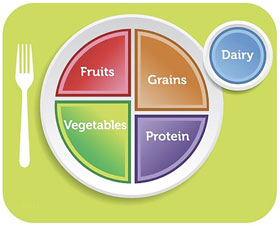How the recent change from a food pyramid to a food plate affects you. News from 360 Fitness: Personal Training Red Deer
You can find this article and more outstanding health and fitness articles from our award winning Online Magazine: by clicking here 360 Fitness Magazine
Remember a few years ago when the tried-and-true food pyramid was modified to be a bit more specific to your needs? Well, the United States Department of Agriculture (USDA) has done it again. This time, they’ve taken away the beloved pyramid altogether and replaced it with something you’re much more likely to find on your table: a plate.
What’s with this dietary change in perspective, and how’s it affect what you put on your plate?
Remember, if you have any questions about how your nutrition plan stacks up the new USDA guidelines, ask your Red Deer personal trainer at 360 Fitness Personal Training and Weight Loss.
A Roundabout Way
With the original food pyramid, foods that should be eaten in the largest quantities were placed on the bottom of the pyramid, creating a solid foundation to your diet. Then came the change. Just a few years ago, there was no longer any true foundation to the pyramid. Suddenly, everything looked equal to one another, as the food groups ran up the pyramid side by side. The only obvious difference with the revised pyramid was the sudden appearance of someone climbing the side of the pyramid, which was supposed to represent the need to exercise on a regular basis.
Since a cursory glance at either of the previous pyramids would leave a first-time viewer stumped as to its purpose, the powers that be decided it was time to make something that was more user-friendly. So they axed the pyramid and made room for the plate. Now, instead of wondering exactly how the pyramid was supposed to work out in day-to-day eating, users can peek at the food plate to make sure they have the right portions of the right foods.
Inside the Plate
As soon as you see the USDA’s new vision for how you should eat, you’re overcome with its simplicity. A colorful plate that you can access at ChooseMyPlate.gov, the plate makes dietary recommendations clear. Half your food should be fresh fruits and vegetables, and the other half should be grains and proteins. According to the USDA’s recommendations, you’ll want to make at least half of your grains whole grains, but thanks to all the readily available whole-grain food options at the store, this should be no problem.
And don’t forget the blue circle sitting at the top right of the plate. You guessed it. You also need to include a little bit of dairy in your daily diet. The secret is to make sure it’s low-fat or fat-free. At the same time you’re modifying the amount of fruits, vegetables, grains, and proteins you eat every day, you should consider cutting back on sodium and sugary drinks. This will ensure everything on your plate goes toward improving your health.
A Smaller Plate
Though you may have a great understanding of the plate that has taken the pyramid’s place, you may still have issues eating too much of a good thing. If you’re trying to lose weight or are having to work extra hard to maintain a healthy weight, there are two small steps you can take that will make it easier than ever to eat the right types of foods in the proper quantity.
Ready to cut back your overeating ways? Hang onto your fork and do the following:
- Trade in your dinner plate for a salad plate. Look a little too small for your appetite? That’s the point! Eat one plateful of food and see if you’re full. If you need a little more, only get a little more, and make it fruits or vegetables.
- Eat like you have all day to do it. In the hustle and bustle of life, it can be hard to eat slowly. Unfortunately, if you eat too fast, you don’t give your brain time to realize your stomach is full. The end result? You overeat. By chewing each bite 25 times, putting your fork down after each bite, and spending time talking during meals, you are more likely to realize when your stomach is comfortably full.
If you are struggling in the weight room to reach your goals or you find yourself wasting more in gym than you want, its time you contact yourRed Deer Personal Training experts at 360 Fitness. 360 Fitness will get you motivated, keep you on track and make your workouts count! On top of that, we will set you up on a personal nutrition plan, goal planner and make sure you succeed in reaching your fitness goals! Call us at 403 347 1707 to set up your FREE goals consultation and tour of our award winning facility. See you soon!
For more great health and fitness articles like this, check out reddeerhealthmagazine.com
Or if you want to check out some great ideas for workouts, visit our 360 Fitness Youtube Page



